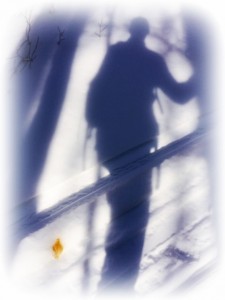Staying Safe and Found in The Backcountry
Benefits of Time in the Backcountry

Whether you’re skiing, hiking, biking , climbing or trail running spending time in the backcountry is great for your overall health. It’s a chance to reconnect with nature, breathe fresh air, slow down and leave the modern world behind for awhile. At the same time backcountry travel keeps your body in motion, active and happy. As with most things, the backcountry does come with risks and one of the most common is getting lost. Not getting lost or, “staying found”, generally comes down to solid preparation and good decision making. Follow these tips to stay safe and found next time you’re heading into the backcountry.
1. Tell someone where you are going.
If you do get lost or something happens, it’s reassuring when someone knows your plans. Leaving notes, maps, return times and other critical information for someone back home is a great safe guard. Beyond that there are resources online which provide additional peace of mind when traveling in the backcountry. Ineversolo.com is a free service that allows you to upload your plans, including maps of the area and your itinerary. Ineversolo also allows you to designate contacts and provide a range of time you expect to be back from your adventure. If you don’t login within the range you set, the service contacts your designees to let them know that something may be wrong.
2. Hike up what you’re going to ski down
This is a golden rule of backcountry skiing, “hike up what you’re going to ski down”. It’s important when skiing on wild snow because it gives you a chance to survey the terrain and see potential hazards before you descend but it’s also a good rule to apply in all backcountry travel. A few years ago, a friend and I were backcountry skiing in the white mountains. We were on a loop that we knew well but a recent ice storm had virtually erased the final section of the loop and we were lost. To complicate matters the trail we had climbed up was too icy to climb down safely. We had placed all of our faith in getting down on the other trail which we could no longer find. If you have the option, taking an out and back approach in unfamiliar territory is wise. It can prevent surprises and it’s comforting to see familiar landmarks on the way back, letting you know you’re on the right trail. Fortunately, my friend and I found our way back by following the next tip for staying found in the backcountry.
3. Carry and know how to use navigational tools.
Having a topographical map, compass and / or GPS unit can help prevent you from losing your way ( if you know how to use them). There is a great article at compassdude.com that explains how to use a compass and topographical map to triangulate your position. Take time to practice and become comfortable using these tools so you’re ready to use them on your next trip.
4. Bring your cell phone.
A phone can’t replace a compass and map but it can be handy to have with you. If you have a signal, you can check the weather, call for assistance and even utilize the built in GPS to pinpoint your location. A lot of the newer smartphones take some pretty awesome pictures too!
5. Follow water.
If you do get turned around, flowing water is a good strategy because water always leads to people. However, you should be cautious about drinking water in the backcountry. Even though it looks clean it may contain bacteria and parasites that can make you sick. It’s best to bring extra water when possible and/ or purification tablets to make sure the water your drinking is safe.
6. Wear bright colored clothes.
It’s not about fashion in the backcountry it’s about visibility. A bright yellow or orange shell can protect you from the elements and help others spot you during a search.
7. Stay where you are
If you are lost one of the best things you can do is stay put. You’ll be easier to find if you stay where you are. Keeping a small survival cache in your pack is a smart idea and can come in handy if you do lose your way. I always keep the following in my pack ready to go for my next trip:
- water purification tablets,
- waterproof matches,
- a whistle,
- a Buck Knife,
- an emergency blanket,
- small first aid kit
Bring some extra food, like oatmeal packets, and extra clothing like a hat, socks and mittens just in case. These items are light, take up very little space and having them in your pack can be a great comfort while you’re waiting for some help. Spending time in the backcountry is one of the best things about being an outdoor athlete. There’s an exciting sense of discovery around every turn and over every mountain. Whether you ski, bike, hike, or run preparing ahead of time and making smart decisions on the trail will bring you home safe and found.
Here’s to your next awesome backcountry adventure!
Steve
Steve Stearns is an avid outdoorsman and host of the Outside Health and Fitness podcast. He shares practical advice, resources and interviews experts from the world of fitness, nutrition and health. His goal is to help others discover new, fun and effective ways to be naturally fit, healthy and happy.
Web:www.outsidehealthandfitness.com
Facebook:www.facebook.com/outsidehealthandfitness
twitter: @sws0926
Google:www.google.com/+stevenstearns





